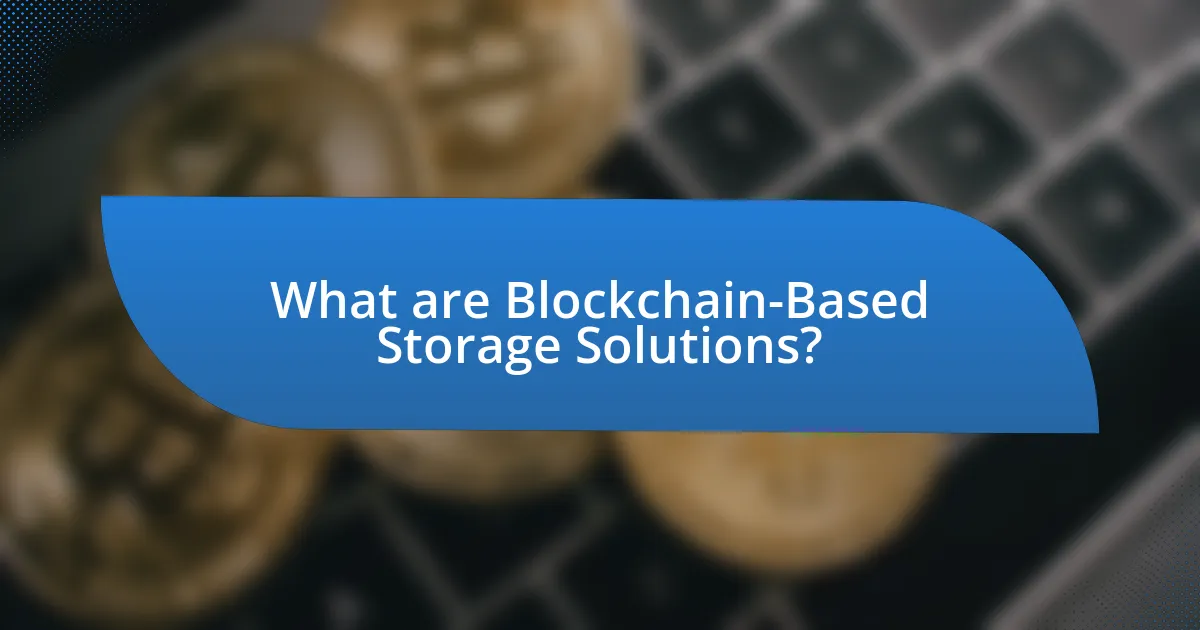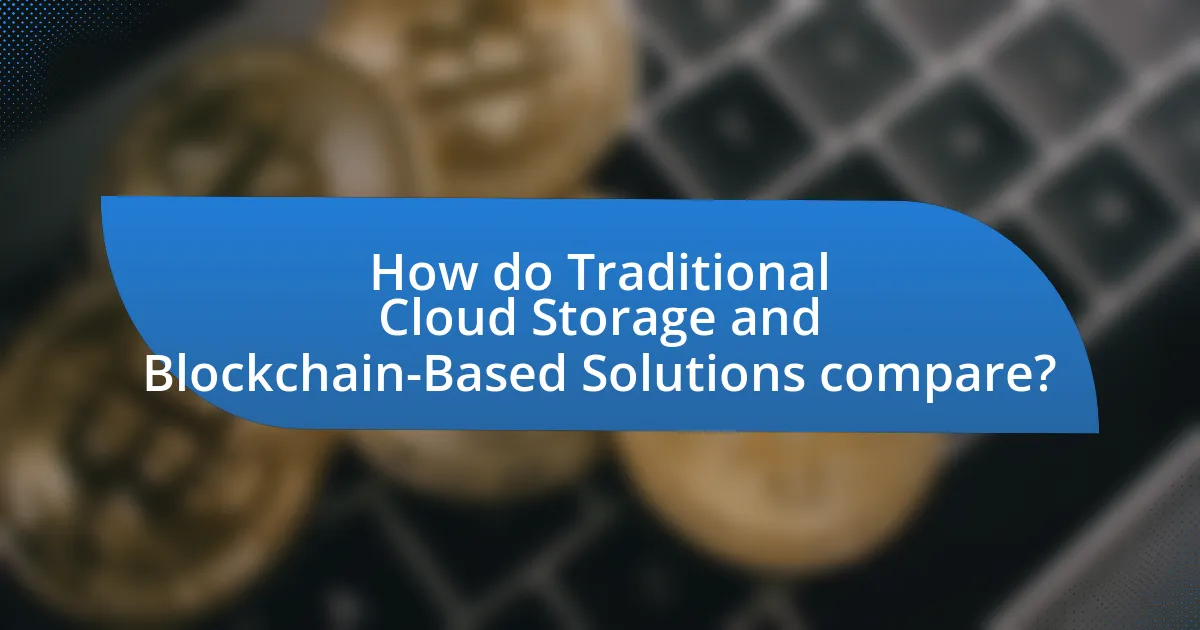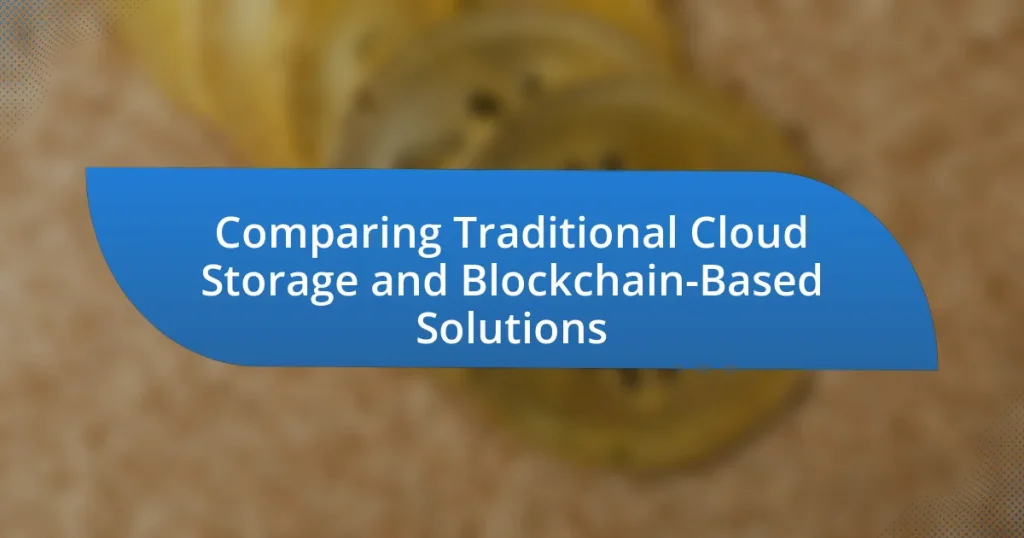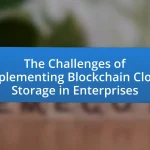The article focuses on comparing traditional cloud storage solutions with blockchain-based storage systems. It outlines the operational mechanisms, advantages, and limitations of traditional cloud storage, emphasizing aspects such as centralized data management, scalability, cost-effectiveness, and security risks. In contrast, it examines blockchain-based solutions, highlighting their decentralized nature, enhanced security, and data integrity. Key differences between the two storage types are discussed, including data ownership implications, security measures, and factors influencing user choice, such as cost and scalability. The article aims to provide a comprehensive understanding of both storage solutions to assist organizations in making informed decisions regarding data management.

What are Traditional Cloud Storage Solutions?
Traditional cloud storage solutions are services that allow users to store data on remote servers accessed via the internet. These solutions typically involve centralized data management, where a service provider maintains the infrastructure, ensuring data availability and security. For instance, major providers like Amazon Web Services and Google Cloud offer scalable storage options that can be accessed from anywhere, facilitating collaboration and data sharing. According to a report by Gartner, the global public cloud storage market is projected to reach $137 billion by 2025, highlighting the widespread adoption and reliance on these traditional solutions for data management.
How do Traditional Cloud Storage Solutions operate?
Traditional cloud storage solutions operate by allowing users to store data on remote servers managed by a service provider. These providers utilize a network of data centers to store, manage, and back up data, enabling users to access their files over the internet. The data is typically organized in a hierarchical structure, allowing for easy retrieval and management. Security measures, such as encryption and access controls, are implemented to protect user data. According to a report by Gartner, the global public cloud services market is projected to grow to $623.3 billion by 2023, highlighting the widespread adoption and reliance on traditional cloud storage solutions.
What are the key components of Traditional Cloud Storage?
The key components of Traditional Cloud Storage include data storage, data management, data access, and security measures. Data storage refers to the physical servers and infrastructure that hold the data, typically located in data centers. Data management encompasses the software and processes used to organize, retrieve, and maintain the data efficiently. Data access involves the protocols and interfaces that allow users to upload, download, and share data over the internet. Security measures include encryption, authentication, and access controls to protect data from unauthorized access and breaches. These components work together to provide a reliable and scalable storage solution for users and organizations.
How do data retrieval and storage work in Traditional Cloud Storage?
Data retrieval and storage in Traditional Cloud Storage involve centralized servers where data is stored and accessed over the internet. Users upload their data to these servers, which are managed by cloud service providers, allowing for easy access and sharing. When a user requests data, the cloud service retrieves it from the server and transmits it back to the user’s device. This process relies on protocols such as HTTP and APIs to facilitate communication between the user and the cloud infrastructure. The centralized nature of this system means that data is typically stored in large data centers, which can lead to potential risks such as data breaches or service outages.
What are the advantages of Traditional Cloud Storage?
Traditional cloud storage offers several advantages, including scalability, cost-effectiveness, and ease of access. Scalability allows businesses to adjust their storage needs based on demand, enabling them to pay only for what they use. Cost-effectiveness is evident as traditional cloud storage typically requires lower upfront investment compared to on-premises solutions, with many providers offering flexible pricing models. Additionally, ease of access ensures that users can retrieve and manage their data from anywhere with an internet connection, enhancing collaboration and productivity. These benefits make traditional cloud storage a popular choice for organizations seeking efficient data management solutions.
How does Traditional Cloud Storage enhance accessibility?
Traditional cloud storage enhances accessibility by allowing users to access their data from any device with an internet connection. This capability is facilitated by centralized servers that store data, enabling seamless retrieval and sharing across multiple platforms. According to a report by Gartner, 94% of enterprises use cloud services, highlighting the widespread reliance on cloud storage for easy data access.
What cost benefits does Traditional Cloud Storage provide?
Traditional Cloud Storage provides significant cost benefits, primarily through reduced infrastructure expenses and scalable pricing models. Organizations can avoid the high upfront costs associated with purchasing and maintaining physical hardware by utilizing cloud services, which typically operate on a pay-as-you-go basis. This model allows businesses to only pay for the storage they actually use, leading to more efficient budget management. Additionally, traditional cloud providers often offer tiered pricing structures, enabling users to select plans that align with their specific storage needs, further optimizing costs. According to a report by Gartner, companies can save up to 30% on IT costs by migrating to cloud solutions compared to maintaining on-premises infrastructure.
What are the limitations of Traditional Cloud Storage?
Traditional cloud storage has several limitations, including dependency on a centralized provider, potential data security risks, and issues with data accessibility. Centralized providers can lead to single points of failure, making data vulnerable to outages or breaches. For instance, in 2021, a major cloud service experienced a significant outage, affecting numerous businesses and highlighting the risks associated with reliance on a single provider. Additionally, traditional cloud storage often involves data being stored in a way that can be accessed by the provider, raising concerns about privacy and unauthorized access. Furthermore, users may face challenges with data retrieval speed and costs associated with large-scale data transfers, which can hinder efficiency and increase operational expenses.
How does data security compare in Traditional Cloud Storage?
Data security in Traditional Cloud Storage is generally centralized, relying on the provider’s security measures, which can lead to vulnerabilities. Traditional cloud services often implement encryption, access controls, and regular security audits; however, they are still susceptible to data breaches and unauthorized access due to their centralized nature. For instance, a report by the Identity Theft Resource Center indicated that in 2020, there were over 1,000 data breaches in the U.S., many involving cloud services. This highlights the risks associated with relying solely on a single entity for data protection.
What challenges do users face with Traditional Cloud Storage?
Users face several challenges with Traditional Cloud Storage, including data security risks, limited control over data, and potential downtime. Data security risks arise from vulnerabilities to hacking and unauthorized access, as evidenced by numerous high-profile data breaches in cloud services. Limited control over data occurs because users must rely on third-party providers to manage and protect their information, which can lead to concerns about data privacy and compliance with regulations. Additionally, potential downtime can disrupt access to critical files, as cloud services may experience outages, impacting business operations and user productivity.

What are Blockchain-Based Storage Solutions?
Blockchain-based storage solutions are decentralized systems that utilize blockchain technology to store and manage data securely. These solutions leverage distributed ledger technology, ensuring that data is replicated across multiple nodes, which enhances security and reduces the risk of data loss or tampering. For instance, platforms like Filecoin and Storj allow users to rent out unused storage space, creating a decentralized marketplace for data storage. This approach not only improves data integrity but also provides users with greater control over their data compared to traditional cloud storage systems, which typically rely on centralized servers.
How do Blockchain-Based Storage Solutions function?
Blockchain-based storage solutions function by distributing data across a decentralized network of nodes, ensuring that no single entity has control over the entire dataset. Each piece of data is encrypted and stored in blocks, which are linked together in a chain, creating a secure and immutable record. This structure enhances data integrity and security, as any attempt to alter the data would require consensus from the majority of the network participants. Additionally, blockchain technology employs cryptographic techniques to protect user privacy and prevent unauthorized access, making it a robust alternative to traditional cloud storage systems that rely on centralized servers.
What are the fundamental principles of Blockchain technology?
The fundamental principles of Blockchain technology are decentralization, transparency, immutability, and security. Decentralization ensures that no single entity controls the entire network, allowing for distributed consensus among participants. Transparency allows all transactions to be visible to network participants, fostering trust. Immutability guarantees that once data is recorded on the blockchain, it cannot be altered or deleted, ensuring the integrity of the information. Security is achieved through cryptographic techniques that protect data and validate transactions, making it resistant to fraud and unauthorized access. These principles collectively enhance the reliability and efficiency of data management compared to traditional cloud storage solutions.
How is data stored and accessed in Blockchain-Based Solutions?
Data in blockchain-based solutions is stored in a decentralized manner across a network of nodes, where each node maintains a copy of the entire blockchain. This structure ensures that data is immutable and tamper-proof, as any changes require consensus from the majority of nodes. Access to data is facilitated through cryptographic keys, allowing users to retrieve or interact with specific data entries while maintaining security and privacy. The decentralized nature of blockchain eliminates single points of failure, enhancing data availability and resilience.
What benefits do Blockchain-Based Storage Solutions offer?
Blockchain-based storage solutions offer enhanced security, decentralization, and data integrity. These solutions utilize cryptographic techniques to secure data, making unauthorized access extremely difficult. Unlike traditional cloud storage, which relies on centralized servers, blockchain distributes data across a network of nodes, reducing the risk of single points of failure and enhancing resilience against attacks. Additionally, the immutability of blockchain ensures that once data is recorded, it cannot be altered or deleted, providing a reliable audit trail. According to a report by Gartner, organizations using blockchain for data storage can achieve up to 30% cost savings compared to traditional methods, highlighting the economic benefits alongside the technical advantages.
How does Blockchain enhance data security and integrity?
Blockchain enhances data security and integrity by utilizing a decentralized ledger system that ensures data is immutable and transparent. Each transaction is recorded in a block and linked to the previous block, creating a chain that is resistant to tampering. This structure prevents unauthorized alterations, as any change would require consensus from the majority of network participants, making it nearly impossible for a single entity to manipulate the data. Additionally, cryptographic techniques secure the data, ensuring that only authorized users can access or modify it. According to a study by the World Economic Forum, blockchain technology can reduce data breaches by up to 80% compared to traditional systems, highlighting its effectiveness in enhancing security and integrity.
What advantages does decentralization provide in Blockchain storage?
Decentralization in blockchain storage offers enhanced security, improved data integrity, and increased availability. By distributing data across multiple nodes, blockchain reduces the risk of a single point of failure, making it more resilient against attacks and data loss. For instance, a study by the University of Cambridge highlights that decentralized systems are less vulnerable to hacking compared to centralized systems, where a breach can compromise all data. Additionally, the immutable nature of blockchain ensures that once data is recorded, it cannot be altered or deleted, thereby preserving its integrity. This combination of security and integrity makes blockchain storage a robust alternative to traditional cloud storage solutions.
What challenges are associated with Blockchain-Based Storage?
Blockchain-based storage faces several challenges, including scalability, data retrieval speed, and regulatory compliance. Scalability issues arise because as the number of transactions increases, the blockchain can become congested, leading to slower processing times. For instance, Bitcoin’s blockchain can handle approximately seven transactions per second, which is significantly lower than traditional payment systems like Visa, which can process thousands per second. Data retrieval speed is often hampered by the decentralized nature of blockchain, where accessing data may require multiple nodes to be queried, resulting in delays. Additionally, regulatory compliance poses a challenge as different jurisdictions have varying laws regarding data privacy and security, complicating the implementation of blockchain solutions across borders. These challenges highlight the complexities involved in adopting blockchain for storage compared to traditional cloud storage systems.
How does scalability impact Blockchain storage solutions?
Scalability significantly impacts blockchain storage solutions by determining their ability to handle increasing amounts of data and transactions efficiently. As blockchain networks grow, the demand for storage capacity and speed increases, which can lead to challenges such as slower transaction times and higher costs for data storage. For instance, Bitcoin’s blockchain has faced scalability issues, with transaction processing times increasing during peak usage, highlighting the need for solutions like layer-2 protocols to enhance scalability. Additionally, research indicates that as the number of nodes in a blockchain increases, the storage requirements for each node also rise, potentially leading to centralization if not managed properly. This relationship between scalability and storage capacity is crucial for the long-term viability of blockchain solutions compared to traditional cloud storage, which can more easily expand resources to meet demand.
What are the potential costs involved in Blockchain storage?
The potential costs involved in Blockchain storage include transaction fees, storage fees, and infrastructure costs. Transaction fees are incurred each time data is added or modified on the blockchain, which can vary based on network congestion and the specific blockchain protocol used. Storage fees arise from the need to maintain copies of data across multiple nodes, which can lead to higher costs compared to centralized storage solutions. Infrastructure costs encompass the expenses related to setting up and maintaining the necessary hardware and software to support blockchain operations. For instance, Ethereum’s average transaction fee can fluctuate significantly, sometimes exceeding several dollars during peak times, illustrating the variable nature of these costs.

How do Traditional Cloud Storage and Blockchain-Based Solutions compare?
Traditional cloud storage and blockchain-based solutions differ primarily in data management and security. Traditional cloud storage relies on centralized servers managed by service providers, which can lead to vulnerabilities such as data breaches and single points of failure. In contrast, blockchain-based solutions utilize decentralized networks, where data is distributed across multiple nodes, enhancing security through cryptographic techniques and immutability. For instance, a study by Gartner indicates that by 2025, 85% of organizations will adopt a multi-cloud strategy, highlighting the growing reliance on traditional cloud systems, while blockchain technology is increasingly recognized for its potential to provide secure, transparent transactions, as evidenced by its adoption in sectors like finance and supply chain management.
What are the key differences between Traditional Cloud Storage and Blockchain-Based Solutions?
Traditional cloud storage relies on centralized servers managed by service providers, while blockchain-based solutions utilize a decentralized network of nodes to store data. In traditional cloud storage, data is controlled by a single entity, which poses risks related to data breaches and loss of control. Conversely, blockchain technology enhances security through cryptographic methods and immutability, making it difficult for unauthorized parties to alter data. Additionally, traditional cloud storage often incurs ongoing subscription fees, whereas blockchain solutions can reduce costs by eliminating intermediaries and enabling peer-to-peer transactions. These fundamental differences highlight the varying approaches to data management, security, and cost-effectiveness between the two systems.
How do security measures differ between the two storage types?
Security measures differ significantly between traditional cloud storage and blockchain-based solutions. Traditional cloud storage relies on centralized servers, where data is protected through encryption, access controls, and regular security audits. In contrast, blockchain-based solutions utilize decentralized networks, where data is secured through cryptographic hashing, consensus mechanisms, and immutability, making unauthorized alterations nearly impossible. For instance, a study by the International Journal of Information Management highlights that blockchain’s decentralized nature inherently reduces single points of failure, enhancing overall security compared to centralized cloud systems.
What are the implications of data ownership in each solution?
Data ownership implications differ significantly between traditional cloud storage and blockchain-based solutions. In traditional cloud storage, users typically relinquish control over their data to service providers, who manage data access, security, and compliance, often leading to concerns about privacy and data breaches. For instance, a 2020 study by the Ponemon Institute found that 60% of organizations experienced a data breach due to third-party vendors, highlighting the risks associated with centralized data ownership.
In contrast, blockchain-based solutions empower users with greater control over their data through decentralized storage, where data is distributed across a network of nodes. This decentralization enhances security and reduces the risk of single points of failure. A report by Deloitte in 2021 indicated that 40% of organizations using blockchain technology reported improved data integrity and security, demonstrating the positive implications of data ownership in this context. Thus, the implications of data ownership in traditional cloud storage involve increased risk and reduced control, while blockchain solutions offer enhanced security and user empowerment.
What factors should be considered when choosing between the two solutions?
When choosing between traditional cloud storage and blockchain-based solutions, key factors include security, cost, scalability, and data integrity. Traditional cloud storage typically offers centralized control, which can lead to vulnerabilities, while blockchain solutions provide decentralized security through cryptographic methods, enhancing data protection. Cost considerations involve not only the initial investment but also ongoing operational expenses; blockchain solutions may incur higher transaction fees. Scalability is crucial, as traditional cloud services can easily expand, whereas blockchain networks may face limitations in transaction speed and capacity. Lastly, data integrity is paramount; blockchain’s immutable ledger ensures that once data is recorded, it cannot be altered, providing a higher level of trust compared to traditional systems.
How do user needs influence the choice of storage solution?
User needs significantly influence the choice of storage solution by determining factors such as data security, accessibility, scalability, and cost. For instance, users requiring high security may prefer blockchain-based solutions due to their decentralized nature and enhanced data integrity, which are critical for sensitive information. Conversely, users prioritizing ease of access and cost-effectiveness might opt for traditional cloud storage, which typically offers user-friendly interfaces and flexible pricing models. According to a 2021 report by Gartner, 70% of organizations cite data security as a primary factor in their storage solution selection, highlighting the direct impact of user needs on decision-making.
What role does cost play in the decision-making process?
Cost is a critical factor in the decision-making process, particularly when comparing traditional cloud storage and blockchain-based solutions. Organizations assess costs to determine the financial feasibility of adopting a specific technology, as expenses directly impact budget allocations and overall return on investment. For instance, traditional cloud storage often incurs predictable monthly fees based on storage capacity and usage, while blockchain solutions may involve variable costs related to transaction fees and infrastructure setup. According to a study by Gartner, organizations that prioritize cost analysis in technology adoption are 30% more likely to achieve favorable financial outcomes. This demonstrates that understanding and evaluating costs is essential for informed decision-making in technology investments.
What best practices should users follow when selecting a storage solution?
When selecting a storage solution, users should prioritize security, scalability, and cost-effectiveness. Security is crucial; users must ensure that the solution offers robust encryption and compliance with data protection regulations, such as GDPR. Scalability is important because users need a solution that can grow with their data needs, allowing for easy upgrades without significant downtime or data loss. Cost-effectiveness should also be evaluated, as users must consider both upfront costs and long-term expenses, including maintenance and potential hidden fees. According to a report by Gartner, organizations that prioritize these factors can reduce data management costs by up to 30% while improving data security and accessibility.


